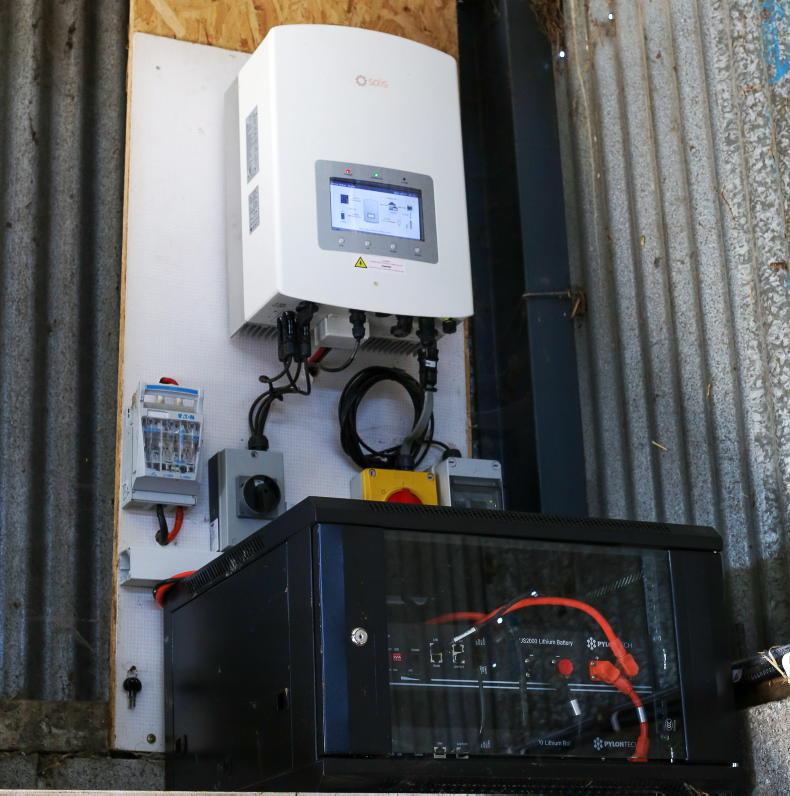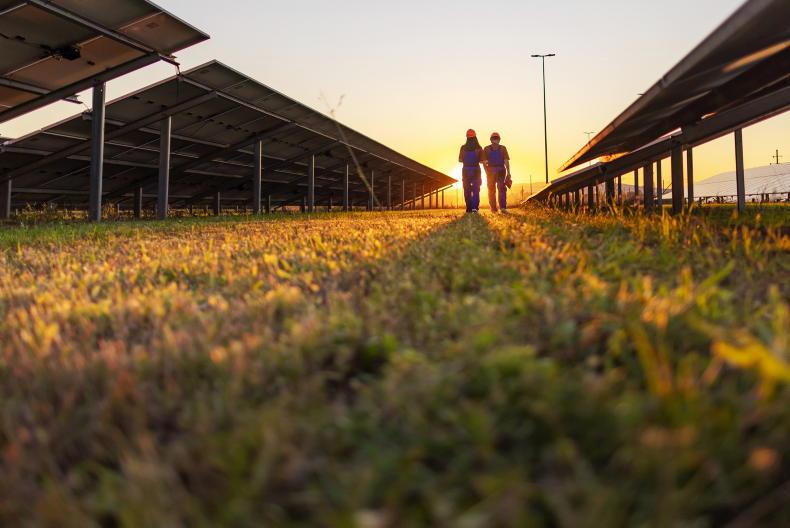Farmers can now apply for the Solar Capital Investment Scheme (SCIS) which offers a 60% grant towards the cost of solar PV panels and batteries. The SCIS is a newly established part of the Targeted Agriculture Modernisation Scheme (TAMS) III. Although the SCIS falls under TAMS III, it has a separate investment ceiling of €90,000, allowing farmers to receive a grant for a solar PV system without affecting their eligibility to receive grants for other items in TAMS III. Over the years, there has been a significant increase in interest regarding installing solar photovoltaic (PV) systems on farms to generate clean electricity. The idea of using free solar power is attractive, and recent changes in retail electricity prices and the introduction of grant aid have made it considerably more viable.

The 60% grant covers the panels, inverter, controller as well as batteries.
The introduction of a 60% grant under the SCIS has further accelerated this trend, making it possible to achieve payback periods of three years or less. Under the new scheme, the farmhouse can also use the electricity generated from the panels, which wasn’t allowed under TAMS II.
While the level of grant aid is generous, the terms and conditions and application requirements of the scheme are demanding, which could deter some farmers from taking advantage of the opportunity. This article runs through the terms and conditions of the scheme.
Grant aid
Under the Department of Agriculture’s new reference costs, the costs of solar PV panels, including inverter and controller, are calculated as follows (all prices excluding VAT):
Reference cost = €1,441 per installed kilowatt + €1,849.Therefore, a 10kWp (peak output of the in kilowatts) solar PV system’s reference cost for the system would work out as:
€1,441 by 10 + €1,849 = €16,259.Farmers are eligible to claim a grant of 60% of this, or a maximum of €9,917.4. Solar PV rechargeable batteries will also be eligible for grant aid of up to 60%.
The reference cost is calculated as follows:
Reference cost = €703 per installed kWh + €753.For a 5kWh battery, the reference cost works out as €4,268. Farmers are eligible to claim a maximum grant of 60%, or €2,560.80.
The cost of solar panels typically depends on the type and quality of panel, as well as the scale of system being installed. For example, a smaller 6kWp solar PV system using the market leading glass-on-glass panel is likely to be more expensive than the Department’s reference cost of €1,441.
However, a larger system, say 30kWp, could come in lower than the Department’s reference costs. The level of grant aid a farmer receives will be the lower of the reference costs or the actual cost (if this is lower than the reference cost listed).
For example, if the actual cost of the 10kWp solar PV system is €15,780, then the maximum grant aid is €9,468 (€15,780 x 60%). If the same system costs €17,000, then the level of grant aid will be based on the reference cost.
What size panels can I install?
The maximum size of PV panels eligible for grant aid is 62kWp. The Department states that if the applicant wishes to apply for non-TAMS support (e.g SEAI) for a larger area of panels, the TAMS III unit must be an “isolated and discrete system”. Remember that you will also have to secure the appropriate grid connection through the ESB.
Under the ESB’s simplified ‘Mini-Generation’ connection process, the maximum size of system which can be installed on a single-phase line is around 17kW. This refers to the size of inverter which would likely support a solar PV system of up to 22-25kWp in output. With three-phase, the maximum size allowed would be 50kW at inverter level, or roughly 75kWp of solar PV output. Another limiting factor is the farm’s maximum import capacity, which also determines the size of system which can be installed.
To export or not to export
The Department states that all of the electricity generated from the grant-aided panels must be used on the farm for agricultural purposes. This also includes powering the farmhouse.
The Department does not allow you to use the electricity for non-farming or commercial purposes, nor is it permitted to export it and sell it through the grid.
This is to prevent farmers having an unfair competitive advantage to other unsupported industries which produce and sell electricity.

The cost of solar panels typically depends on the type and quality of panel, as well as the scale of system being installed.
However, the Department cannot physically stop you from exporting electricity to the grid. Instead, it will limit the size of the solar PV system you can claim a grant on based on your farm’s electricity use.
To determine the amount of electricity required by the farm and the planned electricity supply from the proposed solar PV system, an on-farm solar PV survey must be completed and submitted with the application. Only one house can be included in this demand calculation.
Information such as the Meter Point Reference Number (MPRN) of the electricity meter, yearly, monthly and daily consumption of electricity (this is calculated from the farm’s previous 12 months electricity bills), size and output of the proposed PV panels and battery, as well as mounting details for the system, are included in the solar survey.
Planning permission
Planning permission or a declaration of exemption is only required if the size of the solar PV panels are larger than 300m2 or if your farm is located close to an airport or airfield in what’s known as a solar safeguarding zone. A map of solar safeguarding zones can be found at www.myplan.ie.
If the total area of ground-mounted solar panels is bigger than 75m2, or if the height of the panels exceeds 2.5m, then this will also require planning permission.
Applications for the SCIS are now open via the Department’s agfood.ie website and it no longer accepts paper applications.
There is quite a bit to an application. In the case of solar panels, both a farm layout plan, which details all the existing and proposed buildings, and a farm structure layout plan, which shows the investment structure and building, are needed. The solar PV survey, maps and ownership details are also needed, while planning permission and environmental impact assessments are needed where applicable.
When claiming the payment, multiple documents as well as geo-tagged photographs (via AgriSnap) of the panels need to be submitted. Remember, any costs incurred before the date of submission of the grant application are considered ineligible.
Assessment of scheme
applications
The assessment criteria for the scheme have been called into question by some in the industry. Applications are awarded points based on a number of criteria. Applications receive lower points, and in some cases none at all, where applicants are over 41, farm more than 63ac, are not in an area of natural constraint or whose nitrates production prior to export is below 170kg N/ha.
The aim of the scheme is to encourage the installation of solar panels to displace imported electricity, improving the sustainability and economics of the farm. Many in the industry argue that the above factors have no bearing on whether a farmer should be able to secure a grant on solar panels or not.
That said, we expect this marking criteria to be updated in the coming months. The first tranche of the scheme is expected to close on 16 June 2023.
Farmers can now apply for the Solar Capital Investment Scheme (SCIS) which offers a 60% grant towards the cost of solar PV panels and batteries. The SCIS is a newly established part of the Targeted Agriculture Modernisation Scheme (TAMS) III. Although the SCIS falls under TAMS III, it has a separate investment ceiling of €90,000, allowing farmers to receive a grant for a solar PV system without affecting their eligibility to receive grants for other items in TAMS III. Over the years, there has been a significant increase in interest regarding installing solar photovoltaic (PV) systems on farms to generate clean electricity. The idea of using free solar power is attractive, and recent changes in retail electricity prices and the introduction of grant aid have made it considerably more viable.

The 60% grant covers the panels, inverter, controller as well as batteries.
The introduction of a 60% grant under the SCIS has further accelerated this trend, making it possible to achieve payback periods of three years or less. Under the new scheme, the farmhouse can also use the electricity generated from the panels, which wasn’t allowed under TAMS II.
While the level of grant aid is generous, the terms and conditions and application requirements of the scheme are demanding, which could deter some farmers from taking advantage of the opportunity. This article runs through the terms and conditions of the scheme.
Grant aid
Under the Department of Agriculture’s new reference costs, the costs of solar PV panels, including inverter and controller, are calculated as follows (all prices excluding VAT):
Reference cost = €1,441 per installed kilowatt + €1,849.Therefore, a 10kWp (peak output of the in kilowatts) solar PV system’s reference cost for the system would work out as:
€1,441 by 10 + €1,849 = €16,259.Farmers are eligible to claim a grant of 60% of this, or a maximum of €9,917.4. Solar PV rechargeable batteries will also be eligible for grant aid of up to 60%.
The reference cost is calculated as follows:
Reference cost = €703 per installed kWh + €753.For a 5kWh battery, the reference cost works out as €4,268. Farmers are eligible to claim a maximum grant of 60%, or €2,560.80.
The cost of solar panels typically depends on the type and quality of panel, as well as the scale of system being installed. For example, a smaller 6kWp solar PV system using the market leading glass-on-glass panel is likely to be more expensive than the Department’s reference cost of €1,441.
However, a larger system, say 30kWp, could come in lower than the Department’s reference costs. The level of grant aid a farmer receives will be the lower of the reference costs or the actual cost (if this is lower than the reference cost listed).
For example, if the actual cost of the 10kWp solar PV system is €15,780, then the maximum grant aid is €9,468 (€15,780 x 60%). If the same system costs €17,000, then the level of grant aid will be based on the reference cost.
What size panels can I install?
The maximum size of PV panels eligible for grant aid is 62kWp. The Department states that if the applicant wishes to apply for non-TAMS support (e.g SEAI) for a larger area of panels, the TAMS III unit must be an “isolated and discrete system”. Remember that you will also have to secure the appropriate grid connection through the ESB.
Under the ESB’s simplified ‘Mini-Generation’ connection process, the maximum size of system which can be installed on a single-phase line is around 17kW. This refers to the size of inverter which would likely support a solar PV system of up to 22-25kWp in output. With three-phase, the maximum size allowed would be 50kW at inverter level, or roughly 75kWp of solar PV output. Another limiting factor is the farm’s maximum import capacity, which also determines the size of system which can be installed.
To export or not to export
The Department states that all of the electricity generated from the grant-aided panels must be used on the farm for agricultural purposes. This also includes powering the farmhouse.
The Department does not allow you to use the electricity for non-farming or commercial purposes, nor is it permitted to export it and sell it through the grid.
This is to prevent farmers having an unfair competitive advantage to other unsupported industries which produce and sell electricity.

The cost of solar panels typically depends on the type and quality of panel, as well as the scale of system being installed.
However, the Department cannot physically stop you from exporting electricity to the grid. Instead, it will limit the size of the solar PV system you can claim a grant on based on your farm’s electricity use.
To determine the amount of electricity required by the farm and the planned electricity supply from the proposed solar PV system, an on-farm solar PV survey must be completed and submitted with the application. Only one house can be included in this demand calculation.
Information such as the Meter Point Reference Number (MPRN) of the electricity meter, yearly, monthly and daily consumption of electricity (this is calculated from the farm’s previous 12 months electricity bills), size and output of the proposed PV panels and battery, as well as mounting details for the system, are included in the solar survey.
Planning permission
Planning permission or a declaration of exemption is only required if the size of the solar PV panels are larger than 300m2 or if your farm is located close to an airport or airfield in what’s known as a solar safeguarding zone. A map of solar safeguarding zones can be found at www.myplan.ie.
If the total area of ground-mounted solar panels is bigger than 75m2, or if the height of the panels exceeds 2.5m, then this will also require planning permission.
Applications for the SCIS are now open via the Department’s agfood.ie website and it no longer accepts paper applications.
There is quite a bit to an application. In the case of solar panels, both a farm layout plan, which details all the existing and proposed buildings, and a farm structure layout plan, which shows the investment structure and building, are needed. The solar PV survey, maps and ownership details are also needed, while planning permission and environmental impact assessments are needed where applicable.
When claiming the payment, multiple documents as well as geo-tagged photographs (via AgriSnap) of the panels need to be submitted. Remember, any costs incurred before the date of submission of the grant application are considered ineligible.
Assessment of scheme
applications
The assessment criteria for the scheme have been called into question by some in the industry. Applications are awarded points based on a number of criteria. Applications receive lower points, and in some cases none at all, where applicants are over 41, farm more than 63ac, are not in an area of natural constraint or whose nitrates production prior to export is below 170kg N/ha.
The aim of the scheme is to encourage the installation of solar panels to displace imported electricity, improving the sustainability and economics of the farm. Many in the industry argue that the above factors have no bearing on whether a farmer should be able to secure a grant on solar panels or not.
That said, we expect this marking criteria to be updated in the coming months. The first tranche of the scheme is expected to close on 16 June 2023.











SHARING OPTIONS